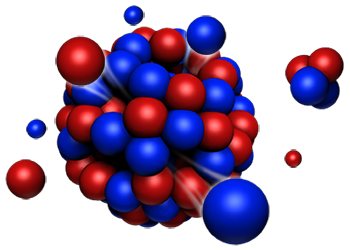Speaker
Description
The objective of producing a high brightness neutron source required designing for a very high peak energy deposition per pulse in the tungsten with energy deposition times on the order of 800 nano-seconds. This produces high dynamic stresses in the tungsten. Average heat removal requirements for the 700 kW beam are reduced by using a rotating target and can be met with water cooling with a tantalum clad on the tungsten to minimize corrosion. Proton beam profiles and target sizes were evaluated with the objective of keeping the peak stresses close to what has been demonstrated in existing tungsten spallation targets.
The analysis required a sequence of separate calculations. For a given model, neutronic calculations provided the energy depositions in the segments. CFD calculations then found the temperature profiles for the hipped tungsten/tantalum block and the surrounding stainless steel vessel with the associated water temperatures. The temperature profiles were imported into an Abaqus standard model to calculate the thermal stresses just before a pulse. An Abaqus explicit dynamic analysis was then done for the tungsten/tantalum block using the thermal stress profiles as an initial condition. Irradiated tungsten properties were used for most cases.
An overview of the design and results including normal and off-center proton beams, peaked beam and diffuse beam cases will be given. Initial evaluation of the consequences of internal by-pass flows will also be given.

